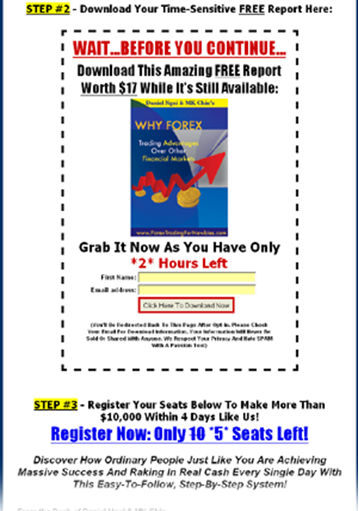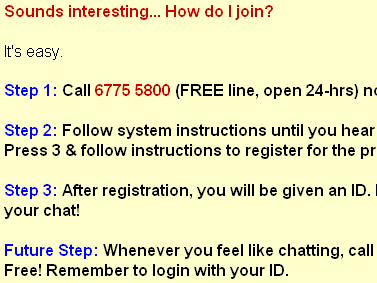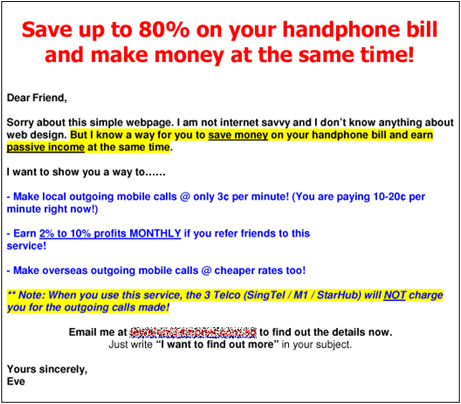Insider Advertising Report
Chapter 8: Content (Part 2)
We've seen in Chapter 2 that the characteristics of the prospects you get from advertising are quite different from the prospects generated from search engine or joint venture.Therefore, when preparing a sales page for advertising, you have to keep them in mind and make sure that your sales page is appealing to such prospects.
Here are some pointers for you when preparing your sales page.
1) Write To Be Scanned
Most people do not read a sales page word by word at first encounter.They skim through it.
They read whatever that captures their attention, such as headline, subheadline, testimonial, highlighted text and screenshot.
Understanding this, when writing a sales letter, you have to write it to be scanned.
How to write to be scanned?
- Use subheadlines
A good subheadline can encourage prospects to keep reading, threading them along from start to finish throughout your sales page, while also providing the glue necessary to keep skimmers skimming. - Use short and simple sentences.
Do you find it hard to understand the above paragraph in red?
I did it on purpose.
It's an example of a complex sentence.
Avoid long and complex sentences like the one above.
Keep your sentences short and simple. - Use short paragraphs
Forget about what the school teaches.
In copywriting, most paragraphs only have one sentence. Paragraphs with 3 or more sentences are too long!
The same is true when writing emails, product reviews or blog.
Use short paragraph or lose the attention of your audience! - Strategically use bold, underline and contrasting colors for words you want your prospects to remember.
- Use bulleted text.
- Use images / screenshots.
- the subheadlines are interesting enough to make me wanting to read on.
- the subheadlines can give me an overview of what the offer is about.
2) Lead Them
Prospects are lazy. They don't like to think. They are in a passive state of mind when reading a sales page.Once you understand this, you can take advantage of it.
Give them step by step instructions. They are likely to follow what you say.
You can lead your prospects in two ways.
 1) Lead them into taking action.
1) Lead them into taking action.You can tell them
STEP 1 - Look at this proof or watch at this video.
STEP 2 - Download this time-sensitive report (basically you want to capture their emails)
STEP 3 - Register for a free preview or ask them to check their email for some special bonus.
See the example on the right.
 2) Lead them by giving them a preview of what they can expect if they take up your offer.
2) Lead them by giving them a preview of what they can expect if they take up your offer.See the chatline example on the right.
The advertiser provided the step by step of what is expected after calling the chatline phone number.
By letting them know what is going to happen, you are also increasing their confidence. So they are more likely to take up your offer.
3) Leverage On The Advertising Media
Let's say you advertise in someone's newsletter.When people see your ad, they will be skeptical. You can lower their guards by saying:
Dear subscriber of YYY newsletter,
If this is your first time seeing this offer, that's probably because you are new to YYY's newsletter
I've been working with YYY for a long time.
Many of his subscribers have benefited from this offer.
Don't just believe in what I say.
Look at what other subscribers like you say about our offer:
......
If this is your first time seeing this offer, that's probably because you are new to YYY's newsletter
I've been working with YYY for a long time.
Many of his subscribers have benefited from this offer.
Don't just believe in what I say.
Look at what other subscribers like you say about our offer:
......
Can you see how you can establish an instant TRUST by leveraging on the advertising media?
Such relationship happens in real-life, where it is easier to trust a friend's friend than a complete stranger.
Notice that I say "many of his subscribers have benefited from this offer"?
This is a great confidence booster, especially if you back it up with testimonials.
Scientifically, this is called the "Cascading Effect". When someone says something is good, more and more people will concur.
The prospect may not know other subscribers, but the fact that they are in the same newsletter gives him the feeling that if other subscribers are benefiting from this product, he should consider giving it a serious look.
There are many variations to this concept. Don't just blindly use the example above.
Remember, when everyone is special, no one is! Be creative.
4) Talk Benefits, Not Features
This is a mistake that many product creators make, including me.I often have to remind myself, "Talk benefits, not features!"
You may wonder, What's the difference between benefit and feature?
Feature is about the product. For example,
- XYZ car delivers 55 miles per gallon in the city.
- Our ladder's frame is made from a lightweight alloy.
- This database has a built-in data-mining system.
- You can save money on gas.
- You can carry it with ease. No more backache lugging a heavy ladder!
- You can pull the most arcane statistics in no time. No more waiting to load.
They only care about themselves.
In other words, they are only interested in "What is in it for ME?"
When you talk about product features, they can't relate.
The features only make sense when you talk in terms of the benefits.
I hope you can see the difference.
Let's look at the mobile phone example again and see if we can identify the features and benefits.

The three sentences in blue are the features.
The benefits are save money and earn passive income.
That's why I highlighted and underlined them!
Can you ignore features and just include benefits?
No.
Features are important in substantiating the benefits.
In fact, logical people such as engineers are sold on features, not so much on benefits. If you tell them it's cheaper, they want to know why it is cheaper.
So it's important that you have both features and benefits in your sales page, with the benefits giving more emphasis.
Remember, after reading a sales page, most people would have forgotten what they've read, especially the features.
All they can remember is the feeling, which is translated from the benefits.
If you don't agree, try recalling what you've read the next time you read a sales page.
5) Short Page Is Not Good. Long Page Is Not Better
There is a long debate on whether long sales page is better than short sales page.To me, long or short does not matter. What matters is it should provide enough content to build confidence and / or infuse curiosity.
If you can build confidence in a few lines, so be it.
But in most cases, you need sufficient content to build enough confidence, not writing rubbish but providing more proofs, more testimonials, more bonuses, more explanations of how your product works and more about why they can trust you.
Remember this: Your aim is to build maximum confidence using minimum words.
So far we have covered how to write an effective headline and what to include in the content of a sales page. The last component of a sales page is the closing, which brings us to the next chapter...
Next Chapter: Closing
Table Of Contents
| Chapter 01: | Not All Ads Are Equal |
| Chapter 02: | Why Advertising Doesn't Work |
| Chapter 03: | Why No Sales |
| Chapter 04: | Where To Advertise |
| Chapter 05: | What To Advertise |
| Chapter 06: | Headline |
| Chapter 07: | Content (Part 1) |
| Chapter 08: | Content (Part 2) |
| Chapter 09: | Closing |
| Chapter 10: | How To Advertise An Affiliate Product |
| Chapter 11: | How To Advertise An Online MLM Program |
| Chapter 12: | How To Advertise A Product That Has No Immediate Needs |
| Chapter 13: | How To Advertise To The Same Group Of People |
| Chapter 14: | How To Advertise A Blog |
| Chapter 15: | How To Be Creative In Your Next Ad |
| Chapter 16: | How To Guarantee Success In Advertising (Bonus Chapter) |
| Chapter 17: | How To Build An Online Business That Lasts (Bonus Chapter) |